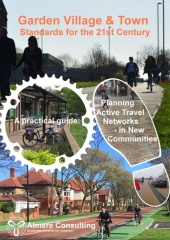Garden Village and Towns Standards for the 21st Century
Document types:
Document geography:
Geographical spread:
The New Towns and Garden Villages built in the 21st Century must be exemplars of sustainable and healthy living, they must deal with the twin challenges of climate change and inactive lifestyles. Health and climate change affect every aspect of planning for new and renewed places with high quality active travel networks being key to good design.
The conditions in which people are born, study, work and grow old have a huge impact on public health which is now a statutory responsibility for Councils. Many local authorities are currently exploring how they make use of new opportunities to improve health through the multiple levers available in local government that shape these influences on health. The design of new communities can contribute to positive health outcomes through green spaces, housing, transport and public realm. Improving health and wellbeing is a requirement of the National Planning Policy Framework, good design is key to achieving this.
Transport accounts for around a quarter of UK greenhouse gas emissions and affects air quality at the roadside. The impacts of climate change are happening now. We are seeing an increase in extreme weather events, with knock-on effects on economies and societies. It is now inevitable that the earth will continue to warm, due to inertia in the climate system, and temperatures are very likely to increase by at least 2°C by the end of the century.
This Practical Guide emphasises the need to undertake active travel network design early in the masterplanning process and to treat it as a serious undertaking based on scientific principles.
This Practical Guide has four main messages:
A comprehensive and safe network implies dense provision of high quality walking and cycling infrastructure.
Providing permeability is not enough, networks must be legible and key routes prioritised over motorised modes.
To ensure that this infrastructure is affordable it must be located carefully and whilst some parts of the network will run through green space, many will not.
Providing high quality infrastructure on principal streets in a development has implications for street width which must be confronted by designers without resorting to reducing the quality of provision.

